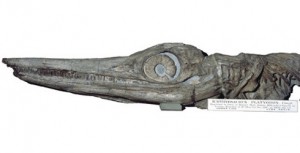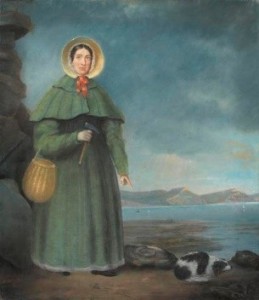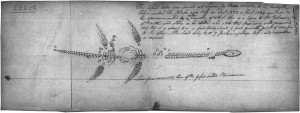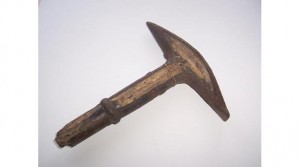Mary(1799-1847) was a 19th century British fossil collector, dealer, and paleontologist who discovered the first ichthyosaur skeleton. She was known as a woman geologist who not only found, but also correctly identified the ichthyosaur skeleton, the first plesiosaur skeletons, the pterosaur skeletons, as well as many others..
 –first Ichthyosaur skeleton identified
–first Ichthyosaur skeleton identified
Mary Anning was born first into a family of ten children in 1799 at Lyme Regis. Lyme Regis was a popular seaside resort in the 18th century among wealthy and middle class European tourists, it also happened to be located close to fossil-rich cliffs near the shores. Lyme Regis’ locals had a long tradition of selling fossils to visitors before Mary’s time, but those fossils were called “curios” and were never identified (“Mary Anning” n.d.).
The Anning family struggled in poverty since their father died in 1810. Mary received very limited education from a Congregationalist Sunday school, where she learned to read and write (“Mary Anning” n.d.). She made her living and supported the family by selling fossils she collected painstakingly from the shore of Lyme Regis.
During the early 1820s, a professional fossil collector named Lt.-Col. Thomas Birch found Anning’s family; he admired Mary’s discovery and sympathized with her struggles, so he decided to sell off all of his fossil collection in an audition and make a generous donation to support Anning’s family (“Mary Anning (1799-1847)”, n.d.). By the middle of 1820s, Mary started to take charge of the family’s fossil business.
Although Mary Anning was later described as “the greatest fossilist” the world ever knew, she did not receive the respect and recognition by the scientific society during her lifetime, and she lived her whole life unrecognized and in poverty. Because of the limitations of her gender and her social class, she was not able to fully participate in scientific research, nor could she be a formal member of the Geological Society of London. Additionally, she did not receive full credit for her work. As a result, her remarkable achievements and life story were only better known long after her death. Mary was included in the list of the ten British women who have most influenced the history of science by Royal Society in 2010 (The Royal Society). Sadly, besides some articles and later fictions based on her story, little is known about Mary Anning.




